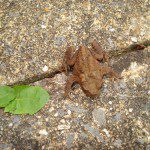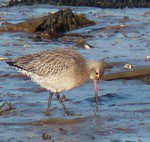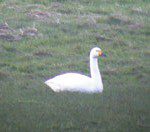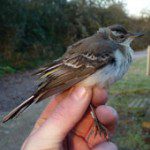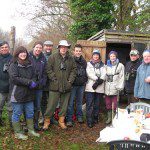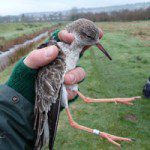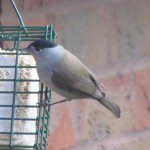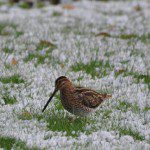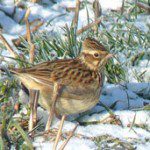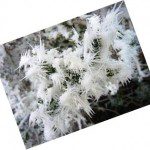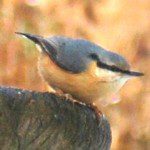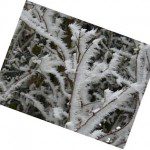NB: The following is reproduced by kind permission of Axe Estuary Birds. Full credit goes to the team that produces the newsletter (see the bottom of the post for specific details). Photographs are credited throughout the text although we are working to preserve the original layout wherever possible in the future.
A Very Merry Christmas to You All, and a Happy New Year
Axe Estuary Birds
No 146 15th December 2010
Images at Colyford by Peter Vernon
The Birds
This period has been incredible for birding on patch, with the cold weather producing an exceptional cold weather movement. Large numbers of wildfowl and waders, thrushes and larks were the main species affected by this.
First and foremost I must mention the Yellow Wagtail currently residing at Colyford WTW – first spotted on 4th. Yellow Wagtail is a summer migrant to the UK, with most birds having left the Country by mid September. The late date, along with the grey and white plumage that this bird shows suggests it may well be of Eastern origin. If it turns out to be a true Eastern Yellow Wagtail then this would be the first confirmed record for the UK. On 14th the bird was trapped and ringed during a routine ringing operation at the WTW, hopefully information gleaned from this will conclusively identify this bird.
Snow on the 2nd kick started an incredible cold weather movement, with totals of 6 Buzzard, 1,453 Lapwing, 30 Snipe, 2,084 Skylark, 2 Woodlark, 90 Wood Pigeon, 1 Mistle Thrush, 63 Fieldfare, 259 Redwing and 86 Starling counted flying west over Seaton. Most of these counts were made between 08:40 – 12:00. Wildfowl were also passing in good numbers, with large flocks of ducks constantly on and flying over the sea. Interesting species and counts included: 2 Goldeneye, 18 Pochard, 12 Tufted Duck, 10 Gadwall, 3 Eider and uncountable numbers of Wigeon and Teal. Also on this date, Woodlarks were discovered in the field opposite Colyford WTW, at least six here – though 18 were counted here the following day.
The day before this incredible day, a Bewick’s Swan was discovered with Mute Swans opposite the entrance to Stedcombe House. It was still present until at least the 7th, soon after this date a Greylag Goose replaced it (which is still present on 15th).
I could write pages about the wildfowl we’ve noted during this period apart from what has already been mentioned for the 2nd. Goosanders have been seen on the Estuary and over the sea on many days, though no more than two at a time. 1,020 Wigeon was the highest count – made on 10th, same day as 12 Gadwall were on the Estuary. Pochard and Tufted Duck have been seen occasionally on the Estuary and on the sea (with counts of 13 and 14 respectively on 8th) and a count of 30 Coot on 9th included 18 on the sea – a highly unusual sight! A single Velvet Scoter was on the sea on 3rd and 10th.
Many notable waders have been seen too, with Grey Plovers noted on 2nd and 8th. Ruff have included up to three birds on Seaton Marshes and the occasional Knot has been seen on the Estuary with a Bar-tailed Godwit also here and a good count of 70 Dunlin on 8th. Two Woodcock were sat out in a field just north of Seaton play park on 3rd, and a single Jack Snipe was in Whitford on 6th with at least 130 Common Snipe.
Up to four Black Redstarts appear to be wintering on patch, although all are quite mobile, and at least one Firecrest can occasionally be seen at Jubilee Gardens in Beer.
Photos: Possible Eastern Yellow Wagtail, Bewick’s Swan, Ruff and Bar-tailed Godwit – Steve Waite; Woodlark – Gavin Haig.
News from Holyford Woods
How still and relatively warm the Woods have been lately without that icy wind. One afternoon a walker’s dog put up 5 Snipe from the open hillside of The Hangings, which flew past me where I was seated on a stump. I had been listening to 2 Ravens, perched in trees a little way apart, one giving three deep rasping croaks, the other answering with a higher pitched single call. Very monotonous over several minutes, it finished with the two birds flying up together, swooping and tumbling. Always a lovely sight. Thanks to a work party of AVDCS members who braved the recent bitter wind, the glade area on the Hangings has been cleared again. The large tree I recently heard crashing down, was just above the top bridge which escaped destruction by a few feet. Another has fallen across the stream lower down. Birds are generally very quiet, though the Nuthatches and Jays are always calling. Now the bracken has collapsed, Paco can again inspect the earths near the main path, and after visiting three, he came out reeking of fox. Jean Kreiseler
Ringing
A very good result for our first canon netting session after qualifying to act alone on December 3rd . Mind you I was somewhat apprehensive, but careful consideration of the improving weather, duck feeding well on grass, plus a little supplement, and a confident team it was decided to go for a catch. The total caught was 191 comprising of 131 Teal, 23 Wigeon, 15 Mallard, 12 Shelduck and a nice surprise of two Shoveler. The by-catch included 6 Black-tailed Godwits, one Ruff and one Lapwing. Two of the Blackwits were controls, one colour-ringed and those that were not were colour-ringed by the team. Overall there were 2 controls and 9 retraps. This was the highest catch since the Group was formed, the previous high catch was of 174 on 10th February 2008. The team were delighted and I was relieved knowing that all birds were safely extracted and processed in good time.
We rang the old year out with suitable refreshments on 13th December. Yes we did catch a few birds as well, totaling 25 as follows: Long-tailed Tit 6(1); Treecreeper 1; Blue Tit 5(2); Greenfinch 1; Robin 5(1); Dunnock 4(1); Blackbird 2; and Wren (1).
The New Year will be rung with a cannon-net catch of duck on 8th January 2011. More details nearer the time.
The Trivia
Alan Bibby reports that there were some unusual birds this afternoon on the playing field between the Underfleet carpark and Seaton marshes: 3 Lapwing, 1 Golden Plover, 2 Snipe & 1 Woodcock which was chased off by two Magpies. “It’s a good site when temperatures go below zero – I think because the row of trees and undergrowth provides some protection from the North wind, and the well-drained turf does not freeze as solid as some of the other fields. In January, it was popular with Redwings and Fieldfares, and there were even two Woodcock and two Snipe feeding in the open. Of course, when it’s warmer there is often disturbance from children and youths. Three more Golden Plover were on the fields between there and the reserve, together with several Curlew, Lapwing & Snipe.”
Anne Smith took this picture in her garden a week before the cold weather set in and thought we might like to see it.
She felt he was rather small for the time of year so safely put him down near her water feature to find some shelter, and hopes he has survived.
Sue Smith, now has a new, and very welcome visitor to her garden, this Blackcap.
John Crabb writes “One thing I have just realised, and it may be of interest to others, is that any of the photographs in the newsletter can be re-sized by clicking on them and then stretching using the little white boxes. This may be useful as I know you are obliged to shrink them to fit your chosen format. When stretched they can be seen much more clearly.”
Helene Buse says “Thought you might like to see this Snipe taken December 2nd. It was firstly on the lawn in front of the house and then went up to the fallen apples in the orchard. Unfortunately I was only able to take the photo through glass. Quite a surprise to see it there!”
Simon Wakely is now photographing the birds in his garden, as this Nuthatch shows. We look forward to more.
Diary Date
Tuesday 28th December Dawlish Warren all day Bird Watch with Ian Waite.
Meet far end of Car Park 10 m An AVDCS Event
This twice-monthly email newsletter is freely available to anyone who would like it, as is a periodic one about the activities of the East Devon Local Group of the Devon Wildlife Trust. Just send me an email with Axe Estuary Birds and/or East Devon DWT in the subject line. Also, for those without a computer, I will send a copy by post if you would like to send me some stamps.
Thanks to those who keep me informed –particular thanks to those of you who have promised me more after Steve “Retires” – please continue to tell me of any unusual, interesting or amusing sightings, and what is about locally, and send any photos you would like to share.
Steve, Mike, Jean and David. davidwalters@eclipse.co.uk. tel. 01297 552616 Mobile 0779 1541 744.

